
Tom Neser
(M.A. Clinical Psychology, BCB)
Note — The article was checked and updated May 2023.
Imagine a treatment that is able to change how the brain functions without the problems and side effects often found with medication.
Neurofeedback or neurotherapy provides real-time brain activity and feedback by measuring brain waves. With the use of specialized equipment and guidance of a trained clinician, neurofeedback helps train the brain to give more of a particular type of brainwave in a particular area in order to affect a specific function.
But first, let us understand a bit more about how the brain works before moving onto neurofeedback and brain training.
Know your brain
The brain is incredibly complex and all that is felt, experienced, thought about, or sensed has a direct correlation to different forms of brain wave activity in different parts of the brain.
The brain works by groups of specialized cells called neurons sending signals in prearranged patterns that result in a wide range of different neurochemicals being released. This results in our thoughts, feelings, behaviors, and memories all happening.[1]
Not only are our thoughts, feelings, and actions determined by the actions of groups of different neurons sending signals from different locations, called Brodmann’s areas, but different groups of neurons in different parts of the brain work together to form specialized networks that combine to enable us to have complex emotions, reasoning, analysis of different situations, and so on.
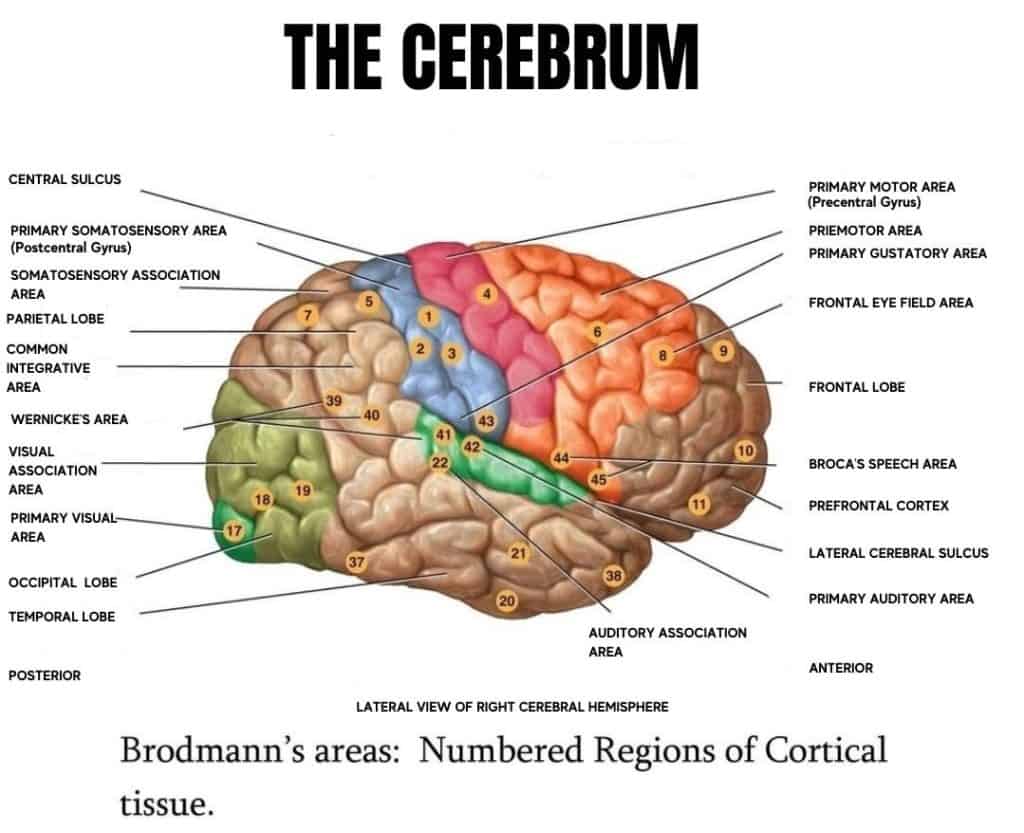
The signals sent by these groups of neurons result in tiny amounts of electrical activity at different frequencies. We call this electrical activity brain waves, and they are divided into different groups called bandwidths according to the number of times a second (the frequency) that the neurons send signals at the same time.

As a rule of thumb we say that the slower the frequency, the closer the person is to a sleep state. The data regarding brain wave frequency slightly vary, but most agree that:
- 1-4 Hz (a Hertz is a cycle per second) is indicative of a sleep state
- 5-7 Hz is frequently found with drowsiness
- 8-12 Hz shows relaxed attention
- 13-30 Hz shows varying states of mental activity, busy brain and, at the higher frequency, can correlate to anxiety.
Now that we know a bit more about how the brain works, we can move onto neurofeedback and explain in more detail what it actually is.
What is neurofeedback?
Neurofeedback or neurotherapy is a type of EEG biofeedback that provides real-time brain activity using specialized equipment that measures brain waves.
It has a number of options to bring about changes in the brain state through changing the brainwaves in different areas. It helps train the brain to give more of a particular type of brainwave in a particular area in order to affect a specific function.[2]
We can train the brain to improve how one part of the brain communicates with another part of the brain which is part of the same network. This is called coherence training. Coherence training usually involves placing up to 19 different very sensitive electrodes in specific predetermined locations on the scalp.
The most commonly used system is called the 10-20 system of placements.
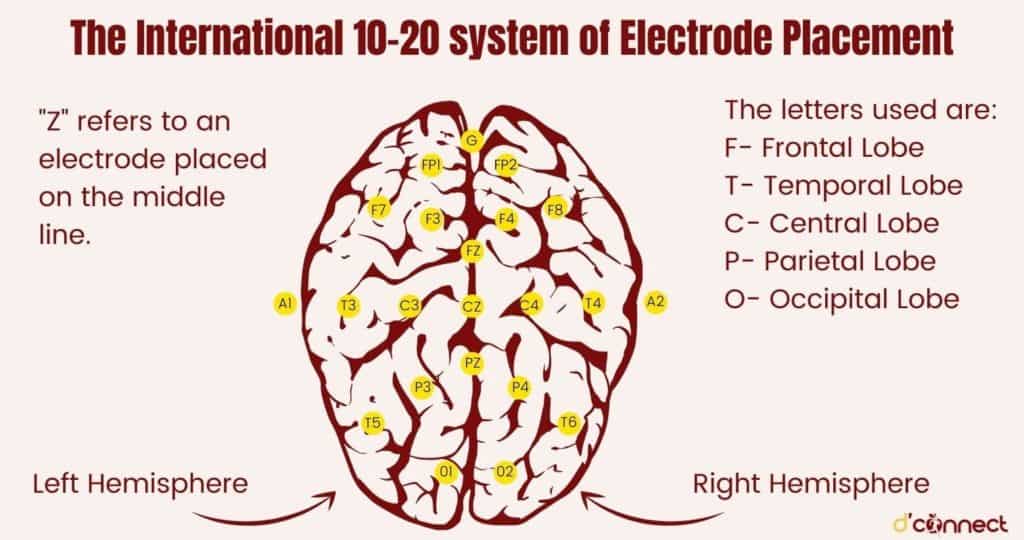
These electrodes measure the amount of electrical activity shown by the neurons close to the electrode. The electrodes have to be very sensitive to measure millionths of a volt of neuronal activity through the scalp and skull and have to be carefully placed to ensure the best possible reading of the electrical activity from the brain.
The measure of good connection is called impedance. The signal from the electrical activity in the brain is then sent through a specialized encoder which measures the size and frequency of brain waves and is then sent on to the clinician’s computer where specialized software will divide the raw signal into the different wave bands.
This signal can be “read” by a skilled clinician or processed further through software to get additional helpful information.
Neurofeedback helps train the brain to affect a specific function
For example, the brain wave readings from a person’s brain map can be compared with a set of readings of perfectly normal brains to determine how different the client’s brain is from what is wanted.
Sometimes the software used will compare the brain map of different brainwaves to research done by sophisticated fMRI or MRI brain scans that are used in hospitals.
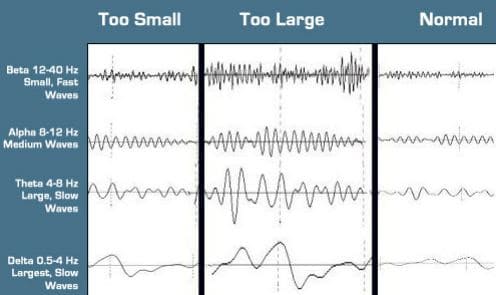
The software can give an indication of which brain sites are underactive or overactive compared to a normal well-functioning population. This helps the clinician develop an understanding of which areas are most likely in need of treatment and what possible brain-based problems may best respond to treatment.[3]
What happens in neurofeedback treatment?
Once the clinician has decided on which brain areas need to be treated, they set up a treatment program. This means that they will decide specifically which brainwave bandwidths need to be changed to give the best chances of improvement.
The brainwave signals from the areas being focused on are projected onto a computer screen and the brain is encouraged to change the way it is working.
Whenever the brain signals change by moving in the direction desired that will give better brain function, the computer signals a reward (a sound, a moving picture, a change in a graph, or a type of computer game). In this way, the brain is shown how to either increase or decrease specific bandwidths of waves.
Initially, the client can be a little confused by this process because they want to “make it happen” and sometimes try really hard. However, the brain waves are less likely to change in the correct way because the client’s efforts are most likely going to cause the wrong parts of the brain to be stimulated.
The best way to help the treatment work is to relax and watch the screen, understand what the training is trying to do, and be curious about how the brain responds.[4]

In the graph above we can see the difference in brain wave activity during neurofeedback sessions in children with ADHD.
During a session, forcing a change in the brain will stimulate wrong parts of the brain
As treatment progresses, the client can see how the brainwave signals are changing, and this proves very encouraging and helps the client to get a better understanding of what helps the brain changes to happen.
Does neurofeedback work?
Unlike treatment with medication, there are no real negative side effects as neurofeedback treats only the specific areas of the brain affected by the condition. Medication affects the whole body and for a number of conditions, such as ADD or epilepsy, medication needs to be kept on being.
Neurofeedback, on the other hand, is a course of treatment that usually only needs to be continued for 3-6 months after which the improvements are such that the client can stop treatment or only get an occasional “top-up”.
While medication can prove very helpful in treating a wide range of situations, for those conditions which are more brain-based, neurofeedback has been shown to be very effective, cost effective, and relatively easy to use.
Although neurofeedback does often take several weeks before positive effects can be clearly experienced by the client, there are many clients who report relatively early on in the treatment feeling calmer and more focused.[5]
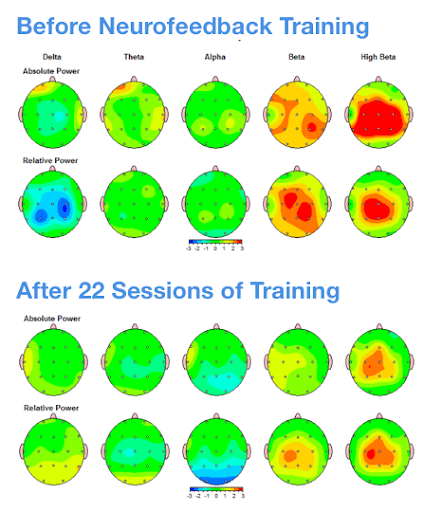
The key points to ensure that neurofeedback treatment does work as best as it can is checking that the clinician providing the treatment has appropriate training and experience, does a proper pre-treatment assessment (most often by doing a quantitative EEG), and uses scientifically validated equipment designed specifically to do neurofeedback.
Because neurofeedback is not a highly regulated industry, there have been some reports of individuals without appropriate training using equipment that is not specifically designed or tested to provide the results we want.
Is neurofeedback scientifically proven and valid?
In 1963, a neuroscientist called Dr Barry Sterman from the University of California was approached by NASA to develop ways to help astronauts control their brain waves and prevent epileptic fits should the astronauts be exposed to rocket fuel. He succeeded in this using cats as his subjects!
Since then the field of neurofeedback has taken off and there are now well over 100,000 published research articles in peer-reviewed journals.
The sheer number of studies successfully undertaken collectively support the usefulness of neurofeedback as a treatment modality and convincingly prove that neurofeedback is a very effective treatment option.[6]
Research has covered every conceivable type of condition and not surprisingly, neurofeedback has differing levels of effectiveness for different conditions. This is where an easy-to-use rating system from 1 to 5 was put in place, with 1 meaning that neurofeedback is not effective and 5 being extremely effective.
For ADD and ADHD, neurofeedback has sufficient supporting scientific evidence to give it a level 5. This is because the background research has been shown to be rigorous and well designed, and there have been meta-analyses that give a convincing and reliable set of results.
Treatment for epilepsy, head injury, or stroke recovery is also very effective at level 4, which indicates a very high probability of significant improvement. However, issues resulting from a current infectious disease process are more likely to have a rating at a level 1 (not helpful as treatment).
A growing number of highly trained professionals such as neurologists, neurosurgeons, psychiatrists, doctors, and psychologists as well as academic researchers are using neurofeedback on a regular basis around the world. Neurofeedback is already well accepted in the United States and Europe and to a lesser extent in Asia and Australia.
Neurofeedback is now regularly accepted as a form of evidence in the US court system.
There have been over 100,000 published research articles in peer-reviewed journals on neurofeedback efficacy
It is ironic that some of the major pharmaceutical companies have funded neurofeedback research to check how the different medications used for brain-based conditions such as autism or ADD/ADHD affect different parts of the brain. This research has been used to help get approval for medications from the FDA.
Can neurofeedback be harmful?
Neurofeedback is one of the safest treatments to use.
However, it is possible to “train” some of the wrong areas of the brain, and this could result in reducing qualities or abilities. The likelihood of this happening is very low if the clinician does a quantitative EEG assessment and interprets it in a competent way before designing a customized treatment program.
Generally, if a client reports that treatment has had an adverse effect, the clinician would stop and re-evaluate what they are doing long before any lasting damage could be caused.
This problem would simply result in slower progress rather than cause any harm.
What conditions can neurofeedback treat?
Neurofeedback has been proven treatment of choice for a number of different conditions. Here are the top 10 conditions most often treated successfully by neurofeedback.
ADHD and ADD: Neurofeedback is regarded by many clinicians as the treatment of choice for ADHD and ADD because of the huge improvements reported in both children and adults being treated.

Reports indicate that those treated showed marked improvement in attention ability, improvement in ability to cope with stress, and improved social skills.[7]
Epilepsy: Some patients who don’t tolerate anti-epileptic medication well respond very well to neurofeedback, which has been shown to be effective in reducing the severity and frequency of most different kinds of epilepsy.[8]
Head injury: People who have suffered a traumatic head injury will often find they struggle with attention, headaches, fatigue, sleep, or controlling impulsive behaviors.
Neurofeedback helps reduce the severity of each of these conditions provided the skull is intact.
Stroke recovery: Clients traditionally have struggled with a long and slow path to recovery following a stroke. Neurofeedback can be helpful and speed up recovery even if the client has lost the capacity for speech.
Anxiety: Many people suffer from debilitating panic attacks and have battled with the effects of different phobias. Neurofeedback has an excellent track record for helping reduce the severity of all forms of anxiety.
RELATED — Increase in Anxiety: Are we “The Anxious Generation”
More recently, neurofeedback has been combined with traditional psychotherapy and is now proving an effective treatment for post-traumatic stress disorder.

Obsessive compulsive disorder: Traditionally, health providers have had issues helping those struggling with severe obsessional compulsive disorder. Neurofeedback can identify specific areas of the brain which are associated with ruminations or obsessions and can help reduce the severity of the condition.[9]
Depression: Approximately one in three people will suffer from significant levels of depression in their lifetime.
RELATED — Introduction to: Depression
Neurofeedback can help create brain states associated with a sense of wellbeing and can also reduce or cure a form of depression associated with an imbalance in activity between the left and right frontal areas of the brain.
Migraines and headaches: Neurofeedback and a related form of treatment called hemoencephalography (HEG) have demonstrated to be very effective in reducing the severity and frequency of migraine headaches, sometimes to the point of the client no longer requiring medication.
Stress headaches as well as other types of headaches, which can be difficult to treat medically, do respond well to neurofeedback. Neurofeedback also helps clients learn to relax and counter the kinds of thoughts that increase stress and tension.
Brain brightening and optimizing performance: While neurofeedback won’t stop us eventually experiencing the problems of aging, causing cognitive decline, it is encouraging to see research showing that neurofeedback will help keep cognitive functioning working to the best possible level a client is capable of.
There are stories of Fortune-500 executives seeking neurofeedback treatment to help make them sharper and more focused as well as students who are worried about exams, seeking a course of treatment to improve their memory retention a month or so prior to studying for exams.
Improving specific brain functions such as maths ability or remedying a learning disorder: Specific abilities such as memory and attention, word-finding, dyslexia and more can all be helped by a course of neurofeedback.

Quantitative EEG (an assessment for neurofeedback) has shown biomarkers or clear indicators in the brain for several of these conditions (such as PTSD, depression, anxiety, OCD and ADD among others).
This is now making treatment of these conditions easier because it also makes diagnosis more certain.
Neurofeedback devices and treatment at home
With the rapid increase in the amount of research proving the effectiveness of neurofeedback, there has been a number of different types of encoder units designed to meet the needs of both clinicians as well as clients desperate to continue treatment on their own despite Covid lockdown.
At the same time a number of skilled researchers and clinicians have created extremely sophisticated software to help analyze brainwave patterns and to help assess treatment needs. This means that treatment units can be bought by clinicians that can work on anything from one site in the brain up to over a hundred and twenty-eight sites at a time.
Most clinicians use encoders that will measure nineteen channels (or sites) at a time. But there are also much simpler encoders which can be linked by cable or Wi-Fi to a laptop at home. These home units have one or two channels and can use software which can connect with a clinician in their office through the internet.
Apart from clinically approved neurofeedback equipment, low-cost devices are also available on the market
This means the clinician will do the initial assessment in their office, develop a treatment program, show the client how to use the home unit and where to place the electrodes on their scalp and then will link in through the internet to watch and guide the client as they do their own treatment from home.
Since the home treatment units can cost a couple of thousand dollars, some clinicians are willing to rent a unit to clients at a very reasonable weekly cost.
What is the success rate of neurofeedback therapy?
Neurofeedback success rates vary according to the skill of the clinician and the type of condition treated as well as the length of treatment.
It is very successful with ADD/ADHD where research indicates it is a treatment of first choice and is able to help most clients being treated. It is also very helpful for treatment-resistant epilepsy and different forms of head injury.
Neurofeedback is not especially helpful in curing conditions such as Parkinson’s or Alzheimer’s although it has been shown to slow the progression of these diseases. It is also helpful in treating learning disorders, anxiety and depression, but a fully successful outcome can be quite varied with these conditions.
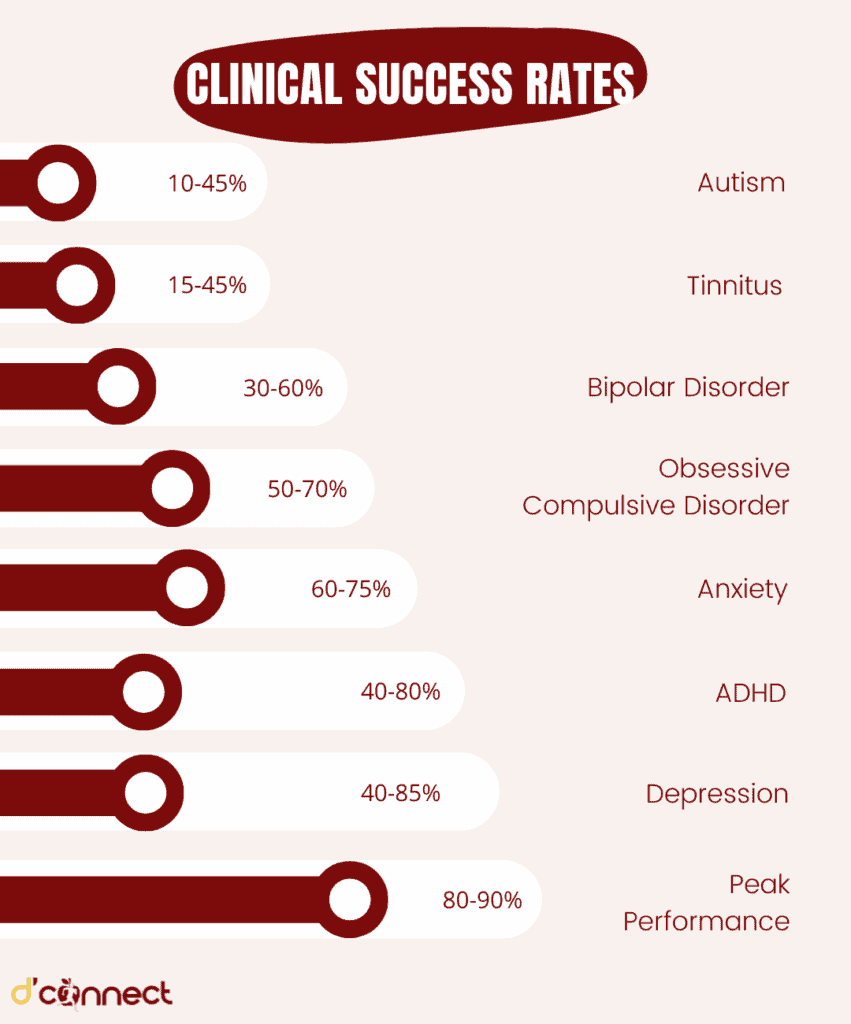
It seems that some conditions are caused by a combination of factors and not just simply brain function.
As a result there are a number of clinicians who are currently experimenting with a combination of neurofeedback and psychotherapy, and use of health supplements.
What is the cost of neurofeedback treatment?
Depending on what you are aiming to achieve with neurofeedback and which clinician is guiding the process, it can cost between $100 and $150 per session. Due to the cost, it is most often done once a week and it can take 20 to 30 sessions to really see lasting positive effects.
With some conditions, it is helpful to have treatment twice a week as this ensures that treatment results can be experienced much sooner and with fewer overall treatment sessions.
Don’t be scared to check with your neurofeedback provider to see if you can arrange a way to have payments set at a rate you can afford weekly and may continue paying it off after treatment is complete.
For more articles on brain training, pain relief and relaxation, please visit our Wellness page. Also, if you would like to know how brain performance and brain health is affected by nutrition and different type of foods, we suggest you have a look at:
Disclaimer – D’Connect does not provide medical diagnosis, advice or treatment and any information published on our website, app and other D’Connect platforms is not intended as a substitute for medical advice. Before taking any action, please consult with your healthcare professional.
Tom Neser is a clinical psychologist of nearly 30 years experience and is one of five people in New Zealand active in using neurofeedback and other advanced forms of technology to help people achieve their potential.
Tom also has his international certification in Biofeedback and currently runs Pain Management and Rehabilitation Services (PMARS) which is a subsidiary of Habit Health, based in Palmerston North. PMARS is an organization of nearly 300 clinicians in New Zealand. It delivers services to ACC clients suffering from pain or sexual abuse as well as services to the NZDF, NZ Police and other government departments.
Tom’s own interests are in using Neuroscience to help people with emotional trauma, closed head injuries and assisting people to achieve and use their optimal abilities. For more details on the work Tom and his team do, please visit Pain Management and Rehabilitation Services for more information.
References
(1) Robbins, J. A. (2008). A Symphony in the Brain: The Evolution of the New Brain wave Biofeedback. Grove Press, New York.
(2) Chapin T. J. Russell-Chapin L. (2014). Neurotherapy and Neurofeedback: Brain Based Treatment for Psychological and Behavioral Problems. Routledge, New York.
(3) Marzbani, H., Marateb, H. R., & Mansourian, M. (2016). Neurofeedback: a comprehensive review on system design, methodology and clinical applications. Basic and Clinical Neuroscience, 7(2), 143-158. https://pdfs.semanticscholar.org/25b2/80e2a6c0d27e9b2fe8f65ec6077dd78da472.pdf
(4) Hammond, D Corydon (2020). The ISNR Comprehensive Biography Neurofeedback Research, International Society for Neuronal Research. https://isnr.org/isnr-comprehensive-bibliography
(5) Roy R. et al. (2020). Neurofeedback for Pain Management: A Systematic Review. Front. Neurosci., 16 July 2020. https://www.ncbi.nlm.nih.gov/pmc/articles/PMC7378966/
(6) Evans J. R. Dellinger M.B. Russell H. L. (Eds). (2020). Neurofeedback: The First 50 years. Academic Press (Elsevier), London.
(7) Cohen M. P. (2020). Neurofeedback 101: Rewiring the Brain for ADHD, Anxiety, Depression and Beyond. Center for Brain, Florida.
(8) Walker, J. E., Kozlowski, G. P. (2005). Neurofeedback treatment of Epilepsy. Child and Adolescent Psychiatric Clinics of North America, 14(1), 163-76. https://www.sciencedirect.com/science/article/abs/pii/S1056499304000720?via%3Dihub
(9) Fisher S. (2014). Neurofeedback in the treatment of Developmental Trauma. W W Norton and Co., New York.






Great work! I strongly agree with this blog. Thank you for sharing this one and also for the reminders and tips. This article is very advantageous, especially to all the parents.
Great article. Thank you for sharing.